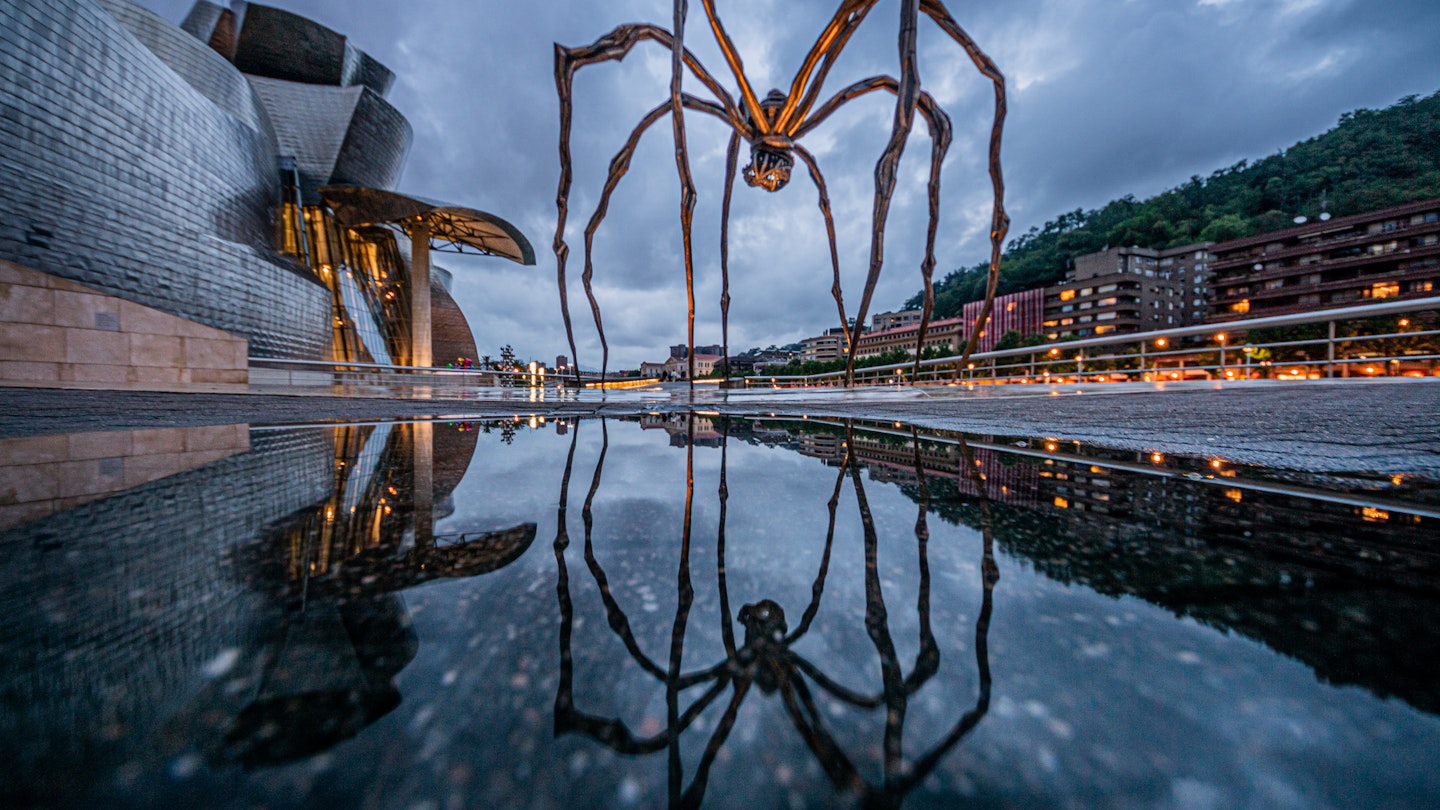After the Nervion River flooded in 1983, the industrial seaport of Bilbao presented a blank canvas, reimagined as the artistic centre of the Spanish Basque Country, hosting the famous Guggenheim Museum Bilbao and a plethora of other attractions.
A City Transformed
While credit for Bilbao’s modern rebirth is often rightfully attributed to the Guggenheim effect, the phenomenon would be virtually impossible to replicate in any other city due to the unique circumstances in which it took place. Faced with the mission to rebuild, the industrial centre embarked on an avant-garde venture that led to its revival as a cultural hub of art and design.
The focal point of that transformation is the celebrated Guggenheim Museum Bilbao, designed by the renowned architect Frank Gehry. Inaugurated by Spain’s King Juan Carlos I and Queen Sofia, the building itself is an architectural masterpiece worthy of the works it houses. With a confounding facade of bending titanium, limestone, and glass, it stands as an iconic triumph in architecture and was an immediate success upon its opening in 1997.
Resembling a boat’s mast rising from the river, harking back to Bilbao’s industrial origins, the Guggenheim’s unfolding structure reveals a blossoming flower from above. Completed on time and within budget, thanks to advances in computer design and Gehry’s meticulous planning, the museum drew 4 million visitors in just its first three years, easily covering its construction costs. The Guggenheim continues to attract increasing crowds, now welcoming over 1 million visitors annually.
The Guggenheim is as beautiful as the works of art it hosts © Joshua Mellin Around the Guggenheim
At the Guggenheim’s entrance, American artist Jeff Koons’ 40-foot tall
Puppy stands guard. A symbol of the city, the giant flowered West Highland White Terrier sculpture is meticulously maintained, with seasonal flowers renewed twice annually. Another of Koons’ classics,
Tulips , is displayed on the museum’s back deck facing the river.
The 30-foot-tall
Maman spider sculpture, designed by French-American artist Louise Bourgeois, crawls along the river’s edge just outside the Guggenheim. Crafted as a tribute to her mother, this arachnid is cast in bronze and stainless steel, with marble eggs, and was installed in 1999. This notable piece is among several iterations of her famous work spread across the globe.
The curving metal exteriors of Gehry’s architectural designs harmonize with a sculpture by British-Indian artist Anish Kapoor,
The Tall Tree & The Eye , located in the Guggenheim’s fountain, reflecting the museum into seemingly endless universes.
The fountain features unique installations, including
Fire Fountain by Yves Klein, creating a fiery moat effect, and the innovative
Fog Sculpture #08025 (F.O.G.) by Fujiko Nakaya, utilizing fog as a medium.
The interplay between the riverfront’s many interactive art installations offers a constantly changing experience and remains a prime location for watching the sunset.
The exterior of the Guggenheim resembles a titanium ship © Joshua Mellin Inside the Guggenheim
Within the museum, several renowned exhibitions are housed. Richard Serra’s
The Matter of Time , occupying the grand gallery 104, consists of a maze of eight pieces of torqued ellipses made of colossal strips of steel, allowing visitors to immerse themselves within the sculpture’s curved walls.
Installation for Bilbao by Jenny Holzer, produced specifically for the city, features provocative slogans across electronic LEDs, enhancing the museum’s dynamic artistic essence. Yoko Ono’s
Wish Tree for Bilbao , located on a quiet terrace at the Guggenheim, invites visitors to hang their hopes and dreams, symbolizing a collaborative effort for world peace. This piece resonates with Ono’s themes of connection and reflection.
The museum features a sculpture by renowned artist Richard Serra © Joshua Mellin Art and Design Around Bilbao
La Salve Bridge, bisecting the Guggenheim, was originally built in the 1970s and is considered a traditional spot of prayer for returning seafarers. Celebrating the museum’s 10th anniversary, a modern red-crowned accent designed by Daniel Buren was inaugurated.
This sophisticated waterfront design made a cameo in the 1999 James Bond film
The World is Not Enough , showcasing the riverfront and its vibrant culture. Just steps from the Guggenheim, Salvador Dalí’s
TERPSÍCORE stands gracefully in a fountain by the Euskalduna Palace Conference Centre.
TERPSÍCORE, by famed artist Salvador Dalí, also sits outside the Guggenheim © Joshua Mellin
Across the river from the Conference Centre stands the impressive Tiger building, crowned with a grandiose sculpture of a tiger. Commissioned in 1942, it predated the flood and foreshadowed Bilbao’s transformation into an art haven.
The Guggenheim has made the city a magnet for modern urban design innovation. The construction of the museum coincided with the re-envisioning of Bilbao’s metro stations by architect Norman Foster, with inviting glass tunnels now known as “Fosteritos” guiding commuters seamlessly from street level.
Located nearby, the Bilbao Fine Arts Museum has amassed a rich collection of over 10,000 works since its establishment in 1914. Also, San Mames Stadium, home to Athletic Bilbao, boasts a sophisticated lighting system allowing for complex animated designs.
Post Views: 118









